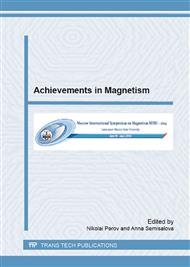p.375
p.379
p.383
p.388
p.395
p.399
p.403
p.407
p.411
Hall Effect Induced by Spin-Wave Excitation in Metal/Ferromagnetic Insulator Bilayer
Abstract:
We investigate Anomalous Hall effect in nonmagnetic metal/ferromagnetic insulator bilayer with rotating magnetization of the magnetic insulator. Spin-orbit interaction of Rashba type takes place near metal/insulator interface. Magnetization of the ferromagnetic insulator rotates with some frequency w by microwave radiation under ferromagnetic resonance condition. This rotation together with spin-orbit interaction in non-magnetic metal layer induced Hall current along the interface. The Hall current appears under zero bias in the system. The dependence of Hall current on the exchange splitting, the magnetization rotation frequency and the barrier height is calculated. We analyze various contributions in Hall current and discuss the limit of small frequencies.
Info:
Periodical:
Pages:
395-398
Citation:
Online since:
July 2015
Authors:
Price:
Сopyright:
© 2015 Trans Tech Publications Ltd. All Rights Reserved
Share:
Citation:


